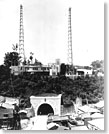History
History of NHK Broadcasting Culture Research Institute (Bunken)
| NHK | YEAR | BUNKEN |
|---|---|---|
Tokyo Broadcasting Station (Shibaura) begins broadcasting under provisional license from temporary quarters |
1925 |
|
Nippon Hoso Kyokai (Japan Broadcasting Corporation), or NHK, founded |
1926 |
|
Radio 2 service begins |
1931 |
Rajio nenkan (Radio Yearbook; now NHK nenkan [NHK Yearbook]) first published |
Number of broadcast reception contracts exceeds 1 million |
1932 |
First “National Radio Survey” |
1934 |
Broadcast Language and Pronunciation Improvement Investigation Committee (now Broadcasting Language Committee) established |
|
|
1943 |
Nihongo akusento jiten (Japanese Accent Dictionary; now NHK Nihongo hatsuon akusento jiten [NHK Japanese Language Pronunciation and Accent Dictionary]) published |
1946 |
NHK Broadcasting Culture Research Institute (Bunken) founded |
|
NHK becomes a special public corporation under the Broadcast Law |
1950 |
First “School Broadcasting Use” survey conducted |
1951 |
Bunken geppo (Institute Monthly Bulletin; now Hoso kenkyu to chosa [NHK Monthly Report on Broadcast Research]) inaugurated |
|
|
1953 |
Sekai no rajio to terebijon (World Radio and Television; now Detabokku sekai no hoso [NHK Databook: Broadcasting Around the World]) inaugurated |
1954 |
First television ratings survey conducted (in Tokyo-Yokohama area) |
|
1955 |
Institute moves to Atagoyama |
|
|
1956 |
Broadcast Museum (now NHK Museum of Broadcasting) opened at Atagoyama. Chosa kenkyu hokoku (Survey and Research Reports; now NHK Hoso Bunka Kenkyujo nenpo [NHK Broadcasting Culture Research Institute Annual]) inaugurated |
Educational television broadcasts begin |
1959 |
|
Broadcasting in color begins |
1960 |
First “NHK National Time Use Survey” (conducted every 5 years since then) |
First successful satellite relay between Japan and U.S. |
1963 |
|
18th Olympic Games in Tokyo |
1964 |
|
1965 |
NHK Yoji yogo jiten (NHK Kanji and Word Usage Dictionary; now NHK shin yoji-yogo jiten [NHK New Kanji and Word Usage Dictionary]) published |
|
1968 |
Completion of the new facility for the Institute and the Museum |
|
Regular FM radio broadcasting begun |
1969 |
|
Transmission of all NHK television programs in color |
1971 |
|
1973 |
First “Survey on Japanese Value Orientations” (conducted every 5 years since then) |
|
|
1977 |
50 Years of Japanese Broadcasting published |
First experimental satellite launched |
1978 |
|
Teletext broadcasting for the hearing impaired begun (Tokyo, Osaka) |
1983 |
|
Broadcast satellite BS-2a launched |
1984 |
|
1985 |
First “The Japanese and Television” survey |
|
| Broadcast satellite BS-2b launched Nationwide teletext broadcasting begins Test satellite broadcasting begins |
1986 |
NHK saishin kisho yogo handobukku (NHK Handbook on Latest Weather-related Terminology; now NHK kisho/saigai handobukku [NHK Handbook on Weather and Disasters]) |
1987 |
NHK Hoso no kotoba handobukku (NHK Handbook on Broadcast Language; now NHK kotoba no handobukku [NHK Handbook on the Japanese Language]) first published |
|
Regular satellite broadcasting begins |
1989 |
|
Broadcast satellite BS-3b launched Hi-Vision test broadcasts begin |
1991 |
Nationwide “Fluctuations of the Japanese Language” surveys begun (conducted annually) |
Hi-Vision test broadcasts phase 2 begins |
1994 |
|
NHK international television broadcasting begins |
1995 |
|
1996 |
Institute website opened |
|
General TV starts 24-hour service |
1997 |
|
Digital international broadcasting service NHK World TV begins |
1998 |
|
| NHK World TV starts 24-hour service | 1999 |
Visitors to the Broadcasting Museum reached 3 million |
Number of BS reception contracts exceeds 10 million. |
2000 |
|
2001 |
Nijusseiki hoso shi (Broadcasting in the 20th Century; in Japanese) |
|
2002 |
Institute moves to Atago Mori Tower. |
|
Digital terrestrial broadcasts begin 50th anniversary of television broadcasting in Japan NHK Archives opens |
2003 |
Broadcasting Museum reopens after remodeling |
2004 |
|
|
| 80th anniversary of the beginning of radio broadcasting | 2005 |
|
| Launching of digital terrestrial broadcasts in prefectural capitals throughout Japan | 2006 |
|
| “Earth-rise” and “Earth-set” movies taken by HDTV camera on Kaguya satellite orbiting moon | 2007 |
“Broadcasting Assessment” surveys begin to gauge nationwide “access rate” (rate of people who watch or listen to NHK for more than 5 minutes a week), held annually thereafte |
| NHK On-Demand program distribution service begun | 2008 |
“Japanese Value Orientations” survey conducted |
| 50th anniversary of broadcasting educational television 20th anniversary of satellite broadcasting |
2009 |
Broadcasting Museum has highest visitor rate on record |
2010 |
“The Japanese and Television” survey conducted |
|
| Great East Japan Earthquake | 2011 |
NHK Kanji Hyoki Jiten (NHK Dictionary for Writing Kanji) Published. |
| Terrestrial TV broadcasting fully digitized. | 2012 |
Research presentation and symposium event "The Great East Japan Earthquake and the media" held. |

 First “Entertainment Program Preferences” survey (Only 5 months after broadcasting begun, listeners surveyed by return postcard method, revealing the popularity of Japanese music, entertainment programs, plays, and Western music. Survey efforts rewarded when number of reception contracts surges from 3,500 at start to over 100,000 by the end of October.)
First “Entertainment Program Preferences” survey (Only 5 months after broadcasting begun, listeners surveyed by return postcard method, revealing the popularity of Japanese music, entertainment programs, plays, and Western music. Survey efforts rewarded when number of reception contracts surges from 3,500 at start to over 100,000 by the end of October.)

